Car Went Through Water and Died – How to Fix?
My daughter had driven through a large puddle of water. I received a phone call, “the car engine has stopped and it won’t start?” I grabbed a tow rope and headed off in the pouring rain to go and rescue her, this is what I found (and how I fixed the issue)…
Topics:
- Why Has my Engine Got Water in It?
- What Happens if Water Gets in Your Engine?
- How to Tell if You’ve Got Water in Your Engine:
- How to Get Water Out of Your Engine:
- How to Remove Water from the Engine:
- Ordering Parts:
- Hints and Tips:
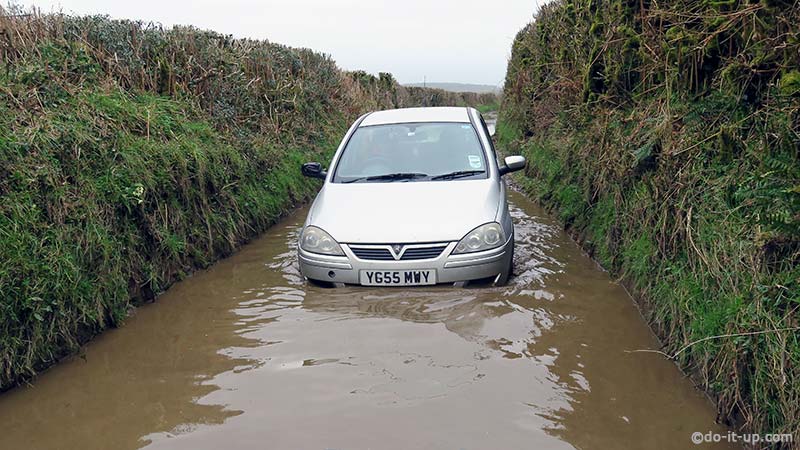
Why Has my Engine Got Water in It?
All combustion engines need the oxygen in the air around us as part of the air fuel mixture to run the engine. Vehicles suck in air through an air intake, (usually near the front of the vehicle).
When going through a large puddle of water, engines can suck this water into the engine through the air intake. Some vehicles are more prone to sucking in water (when going through large puddles), as each vehicle can have their air intake positioned at a different height.
Hence… When driving through water, it’s important that you drive slowly. This is so you don’t cause a bow wave of water which can reach the air intake, (causing water to get sucked into the engine). If the water is really deep, it doesn’t matter what you do. If the height of the water is greater than the height of the air intake, the engine can suck in water. This is why you see some 4×4 vehicles fitted with air snorkels, so they can go through deeper water.
Image Showing the location of an air intake and intercooler (usually hidden behind the bumper).

What Happens if Water Gets in Your Engine?
When water reaches the engine cylinders, it can get compressed by the pistons. The compression of the water causes a hydraulic action (hydrolock, or hydrostatic lock), which in turn prevents the pistons from moving. It can also sometimes cause damage to engine components.
A good illustration of hydraulic force can be seen with a mechanical digger or excavator. A mechanical digger uses hydraulics to power it’s arms and digging buckets. The hydraulic force allows a digger to easily lift heavy objects and dig big holes. Hence the potential for possible damage to engine components from a water based hydraulic action inside the engine.
In many cases, as long as you were traveling at slow speed, the engine will stop (stall) before any damage occurs. However, if travelling at speed, major damage can occur.
Section Topics:
- What Happens if Water Gets Into Your Air Filter:
- What Happens if Water Gets Into a Turbo (if fitted):
- What Damage can be Caused by a Hydrolocked Engine:
What Happens if Water Gets Into Your Air Filter:
Water can get into an air filter. Normally this should only be in small amounts. It’s a normal occurrence, (damp air, rain, fog, etc). Often the air filter housing (box) will have a drain in it for these reasons. However, if the car goes through a large puddle and the engine has sucked in water and stopped, it’s a different matter. There is a difference between a slightly damp air filter and a sopping wet one.
Note:
Its is always preferable to have a dry air filter…
What Happens if Water Gets Into a Turbo (if fitted):
Turbo’s don’t usually like water. However, if you have just been through a puddle and sucked up some water (and you were driving slowly) you should probably be OK, (if the turbo is not sat in water long term, and all the oil seals are good). Check your engine oil for water contamination though, as this may have an effect.
What Damage can be Caused by a Hydrolocked Engine:
Some examples:
- Bent connecting rods:
- Head gasket failure.
- Cracked components (crank, head, block, bearings, etc).
- and others…
How to Tell if You’ve Got Water in Your Engine:
If the engine won’t start…
- And the battery appears to be sufficiently charged (the hazards and other ancillaries, lights, fans, etc appear to work).
- When trying to start the engine, it won’t turn over at all (maybe a slight movement, but not a full rotation).
- The car is (was) sat in a large puddle of water?
If this is the case, there is probably nothing else for it, other than to wade into the large puddle and attach a tow rope to get the vehicle home.
Note:
It may be tempting to try and bump start the vehicle, but you could cause damage (if there is water inside the engine)… It’s best to get the vehicle home and investigate.
How to Get Water Out of Your Engine:
This applies to both diesel and petrol engines. The repair may involve different tasks, dependent on what’s fitted to the engine.
A List of Potential Issues:
In the order that water would have entered into the engine:
- Water in the Air Filter Housing:
- Turbo (if fitted) Full of Water:
- Intercooler (if fitted) Full of Water:
- Connecting Pipework Full of Water:
- Water Inside the Engine Cylinders:
- Exhaust Full of Water:
- Water Contamination:
- Damaged Glow Plugs (Diesels):
Water in the Air Filter Housing:
The first thing to get flooded is the air filter and air filter box. As water gates sucked in, the air filter box fills with water and the air filter will get saturated.
Turbo (if fitted) Full of Water:
The turbo is next (if fitted). The turbo can also suck water in, as well as blow it into the engine. Generally, it just fills with water.
Intercooler (if fitted) Full of Water:
The intercooler (if fitted) cools the air as it exits the turbo. It’s a small radiator that is normally positioned near the front of the car for cooling purposes (see the intercooler image above). Don’t get confused with the water filled engine cooling radiator, which is often situated near the intercooler. The intercooler can be difficult to see, as it can be hidden behind the front bumper. This can also fill with water.
Connecting Pipework Full of Water:
Any of the air intake pipework can have water in it. If water is present, it will have to be drained or blown out.
Water Inside the Engine Cylinders:
When the engines pistons go up and down, it will cause a suction. This pulls in any water that is in the air intake system pipework. Because of the density of water, and the lack of combustion (due to the ingress of water) the engine stops and any rotation becomes locked by the hydraulic action of the water (hydrolock, or hydrostatic lock).
Exhaust Full of Water:
The exhaust on a vehicle is normally on the underside at the lowest point. It will usually blow away any water. But, if the vehicle becomes overwhelmed by the depth and the engine stops, water will flood in.
Water can also enter the exhaust from the engine. It can get sucked in through the air intake and the pistons will try and expel the water out through the exhaust. Just in the same way as it expels the spent gases from the combustion of fuel.
Water Contamination:
If the water is really deep, it can enter the fuel and oil system, especially if the vehicle has been sat in water for some time:
- Check the oil for possible water ingress (milky brown streaks or sludge in the oil filler cap or on the dipstick).
- Water ingress into the fuel tank, filters and fuel system (engine misfires, fails to run or there is low power).
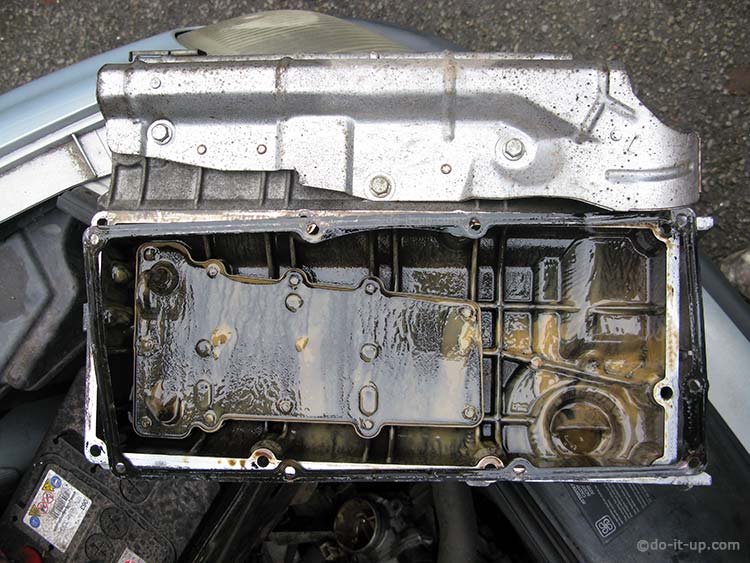
Both the oil and fuel can be drained and flushed. Any filters will have to be replaced.
Damaged Glow Plugs (Diesels):
For diesel engines, the glow plugs can be damaged when you try and start the engine (when full of water). This is because the glow plugs are trying to heat a large body of water, rather than just an air fuel mixture. The damage may only become apparent later on during cold weather, when the glow plugs are most needed.
Therefore, disconnect the electrical connections from the glow plugs whilst attempting to turn over a diesel engine (when full of water).
More information on glow plugs can be found here: Diesel Won’t Start When Cold – How to Fix Glow Plugs: (Opens in a new window / tab)
How to Remove Water from the Engine:
The order in which the water is removed from the engine is only a suggestion, but it may make it an easier process…
The method here is split into three parts:
Part 1:
Emptying the water so the engine can run…
- Preventing Further Water Ingress Into the Engine:
- How to Empty Water Out of the Connecting Pipework:
- How to Remove Water from the Engine Cylinders:
- How to Empty, or Blow Water Out of the Exhaust:
Part 2:
Starting the engine…
Part 3:
Removing the rest of the water…
- How to Empty Water Out of the Turbo (if Fitted):
- How to Empty Water Out of the Intercooler (if Fitted):
- Emptying Water Out of the Turbo and Intercooler at the Same Time:
- How to Clean and Dry a Saturated and Flooded Air Filter and Air Box:
Part 1:
Emptying the water so the engine can run…
Preventing Further Water Ingress Into the Engine (during the repair):
If your engine has sucked in water, there could be water in most of the pipework and air intake components. If you clear the water from the engine cylinders, you could end up sucking in more water, from the rest of the air intake system that’s still flooded. Therefore you need to break apart the air intake system (make gaps) to prevent more water flooding in.
How to Empty the Water Out of the Connecting Pipework:
Where to break open (undo) the air intake pipework to let water out (this does not drain the water from the engines cylinders):
- The first place is between the air filter box outlet and the turbo (if fitted). If a turbo isn’t fitted, then just undo the pipe and break open the pipework at the air filter box outlet.
- If a turbo is fitted, undo and break open the pipework on the outlet side of the intercooler.
Notes:
- When undoing and breaking open pipework, make sure the pipes are misaligned. If the pipes are not separated properly, water can still jump the gap and get sucked into the engine.
- Check for low points in the air intake pipework. Are there any places where the pipework can be undone and the pipework released to drain water?
- Have a look at the air inlet and outlet side of the turbo (if fitted). Does this need to be drained?
- Check water isn’t draining over electrical components.
How to Remove Water from the Engine Cylinders:
Once you have prevented any further water from entering the engine, we can now start to remove (expel) the water from the engine cylinders.
- Make sure the battery has a reasonable amount of charge on it.
- Beware – Fuel and water can be ejected from the engine, into the engine bay and surrounding area.
Safety Precautions:
Make sure no-one is standing near the engine when it is being turned over. Water and fuel can be ejected with force causing injuries. Please wear the appropriate PPE.
Section Topics:
Petrol Engines:
- If you can, locate the fuse for the fuel system. Remove the fuse. Note: There can be a mechanical pump driven by the engine when it turns over.
- If needed, remove the engines acoustic cover.
- Take a note of the position of the HT leads.
- Carefully remove all the spark plugs.
- If needed, place something over the engine (like a rag) to reduce the distance water and fuel are ejected. Note that you don’t want water going back into the spark plug holes.
- For safety reasons, make sure no-one is stood near to the engine (water and fuel being ejected under pressure).
- Turn the engine over. You should see water and fuel being expelled from the engines cylinders, through the spark plug holes.
- Listen for any noises which could mean the engine has been damaged. If you hear any unusual noises – Stop!
- Replace the spark plugs and HT leads.
Diesel Engines:
- If you can, locate the fuse for the fuel system. Remove the fuse. Note: There is often a mechanical pump driven by the engine when it turns over.
- Disconnect the glow plugs (see the section ‘Damaged Glow Plugs‘ above). Will open in a new tab…
- If needed, remove the engines acoustic cover.
- Using Method A or B:
- Method A:
- Locate the fuel injectors.
- Carefully remove the fuel injectors as per your vehicles repair manual.
- Fuel systems can be under pressure. Consult the repair manual. Please wear the appropriate PPE.
- Make a note of where each fuel injector came from, as they can be fitted (and programmed) for a specific position.
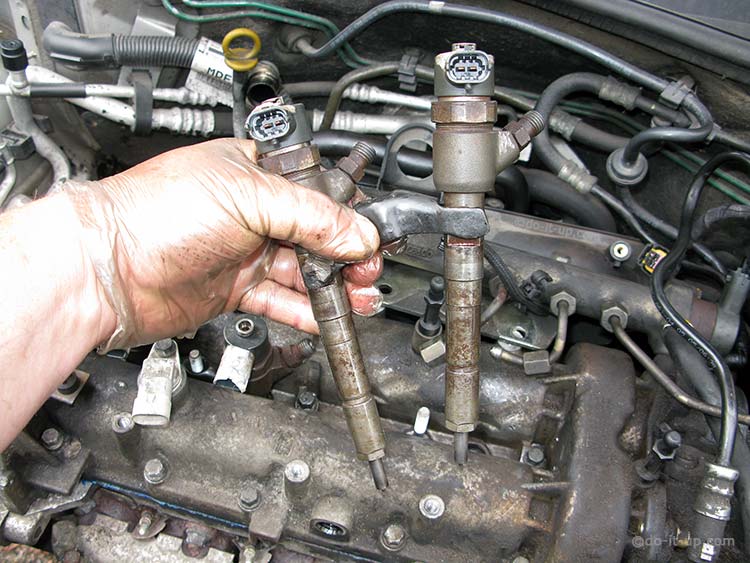
- Method B:
- Please note that Method B may not work, as you will be attempting to eject water through a much smaller hole. If you can remove the glow plugs easily, it may be worth a try?
- Locate the glow plugs. More info on glow plugs can be found in the article “My Diesel Won’t Start When Cold – How to Fix Glow Plugs“ : (Opens in a new window / tab)
- Carefully remove the glow plugs as per your vehicles repair manual.
- Important: For safety reasons, make sure no-one is stood near to the engine – Water and fuel may be ejected under pressure.
- If needed, place something over the engine (like a rag) to reduce the distance water and fuel are ejected.
- I screwed some spare bolts (clean ones) into the fuel connections, to reduce the potential for fuel going everywhere…
Note:
Method B will eject water through a much smaller glow plug hole. Therefore the water is under greater pressure. An attempt should be made to turn the engine over by hand first, to lower the risk of causing damage to the engine, and for safety reasons (water pressure). If there are any issues, stop and remove the injectors to expel any water.
- Turn the engine over (after turning by hand – See the note above). You should see water and fuel being expelled from the engines cylinders, through the fuel injector holes.
- Listen for any noises which could mean the engine has been damaged. If you hear any unusual noises – Stop!
- Replace the injectors.
Notes:
- The process of ejecting the water and fuel from inside the engine, can cause fuel and water to be sprayed everywhere.
How to Empty or Blow Water Out of the Exhaust:
If you have sucked water into the engine, the exhaust will have filled with water. This is because of the depth of water and the exhaust being normally fitted on the underside of the vehicle, the lowest point (other than the wheels).
In pushing the vehicle from the water, and towing it home, you will have hopefully passed a few small upward hills. This would allow the water to run out of the exhaust. There may be some water still in the exhaust, (in the low lying areas). This can get blown out of the exhaust when the engine eventually gets started, though you may get some dirt, soot and muck come out of the exhaust at the same time.
Part 2:
Starting the Engine:
Make sure you have completed the following:
- You have expelled all the water from the engine cylinders.
- There were no unusual engine noises when turning the engine over to expel the water.
- The spark plugs, or injectors, etc have been reinstalled.
- If you removed the fuel system fuse, remember to replace it.
In this example, the engine is being started with the air filter, turbo (if fitted) and intercooler (if fitted), disconnected.
The reason we try and start the engine before clearing water out of all the other components, is to prove no damage has occurred to the engine, (so as not to waste effort). And… we may be able to use a running engine to assist us in removing water from the ancillary pipework (see below).
Important:
- Make sure the engine air intake pipe is disconnected near to the air intake manifold, (providing a clean break in the air intake system).
I.e. When the engine is started, air will be sucked into the engine. This suction could draw any water left in the remaining pipework back into the engine causing it to lock up.
Try to start the engine.
It may take a little while for the engine to start, as there may be water still in the exhaust that needs to be blown clear.
A diesel engine may be difficult to start, if the glow plugs (they heat the cylinders to aid starting) have been damaged by water in the engine cylinders. This will be more noticeable during colder weather. I have another article on glow plugs ‘My Diesel Won’t Start When Cold…‘ if you need more info.
If the engine starts successfully, we can now look at emptying water from the rest of the air intake system.
Notes:
- You will hear the air being sucked into the engine, as the air intake system will have been disconnected.
- This is the point where more water can get sucked in if the air intake pipe hasn’t been properly disconnected and moved out the way from the rest of the system.
- Listen for anything unusual.
- The turbo (if fitted) can also blow water out of its pipework, if the engine is successfully started.
Part 3:
Removing the rest of the water…
How to Empty Water Out of the Turbo (if fitted):
There are two potential methods:
- Disconnecting the pipework at the air inlet and air outlet of the turbo. This may allow some water to drain out.
- Starting the engine will cause the turbo to rotate. This can blow out any water in the turbo and its pipework, without having to disconnect all the turbos pipework (The intercooler pipework needs to be disconnected. see the notes and ‘How to Empty Water Out of the Intercooler (if fitted):‘ below).
Notes:
- Method 2 – Using a running engine to blow the water out of the turbo (and it’s pipework), may not be a recognised method for your particular vehicle. so, if in doubt, empty the pipe work of water before starting the engine.
- Beware – When running the engine, the turbo could blow any unseen water out of any open ended pipework, even if you think the water has drained.
How to Empty Water Out of the Intercooler (if fitted):
There are two potential methods:
- Disconnecting the pipework at the air inlet and air outlet of the intercooler, may allow some water to drain. It can sometimes involve the removal of the front bumper, dependant on where the intercooler is located.
- If the turbo pipework is connected to the intercooler. Starting the engine may blow water out of the intercooler, without having to disconnect any pipework (The intercooler outlet pipework needs to be disconnected. See below – Emptying Water Out of the Turbo and Intercooler at the Same Time: )?
Notes:
- Beware – When running the engine, the turbo could blow any unseen water out of any open ended pipework, even if you think the water has drained.
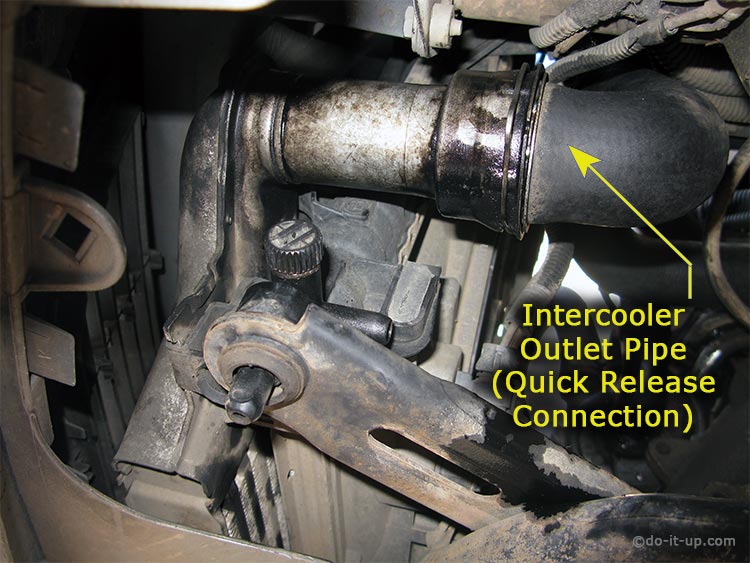
Emptying Water Out of the Turbo and Intercooler at the Same Time (if fitted):
If you’re lucky, may may be able to blow water out of the turbo and intercooler at the same time. I did this by:
- Disconnecting the pipework on the outlet side of the intercooler and disconnecting the air filter from the air intake system pipework.
- I made sure the disconnected pipework from the outlet of the intercooler was properly separated, as I didn’t want any water to jump the gap and get into the engine when the engine was run 1.
- I started the engine. The turbo rotation blew water from the pipework.
- The intercooler, turbo and pipework may have low points where water may remain. I therefore took the vehicle for a short drive to aid the removal of any water. Driving the car causes the water to slosh around and increase the chances of all the water being expelled. Plus the flow from the turbo will cycle up and down with the change in engine revolutions, aiding the expulsion of water.
Notes:
Beware of the following…
- When running the engine, the turbo could blow any unseen water out of any open ended pipework, even if you think the water has drained.
- The engine performance will be sluggish as the turbo will have been effectively disconnected from the air inlet to the engine.
- There will be no protection against debris being sucked into the engine, as the air filter has been removed. However, this shouldn’t be an issue for shorts periods of time (as long as there isn’t a dusty atmosphere present).
- This method of running engine to blow the water out of the turbo, intercooler (and it’s pipework), may not be a recognised method for your particular vehicle. so, if in doubt, empty the pipe work, turbo and intercooler of water, before starting the engine.
- 1 When I carried this out, I didn’t make sure there was sufficient separation between the open ends of the pipework. I started the engine and the turbo blew water through the pipe work, which jumped the gap between the open pipework. The engine sucked in the water,. and I had to clear the engines cylinders for a second time.
How to Clean, Dry, or Replace a Saturated and Flooded Air Filter and Air Box:
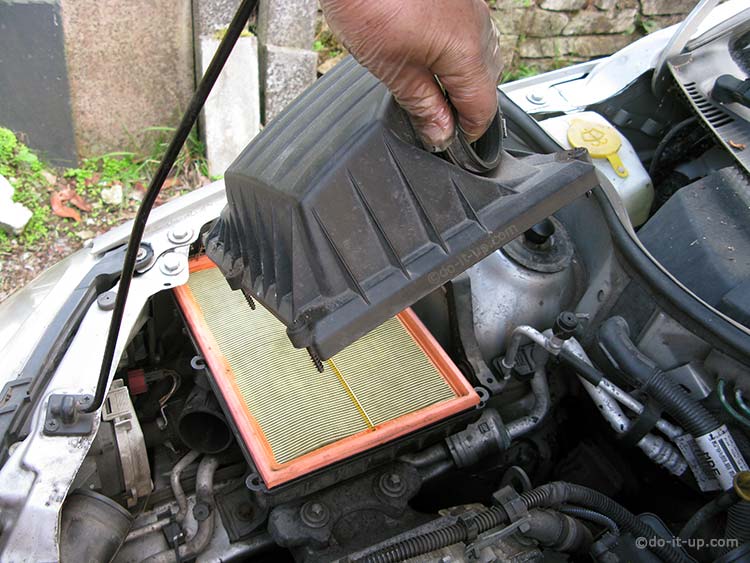
If you’ve sucked water into your engine, the water will have to have gone through the air filter and its housing. You will need to dry this out and remove any debris:
- Remove the air filter box cover.
- Remove and check the air filter. If the air filter is new, you may be able to dry it out. If not, replace.
- Check the air filter box and pipework for water. Drain and clean as necessary. Sometimes it’s easier to remove the air filter box for cleaning (dependant on the vehicle).
- Check the air inlet pipework to the air filter box for any water.
Ordering Parts:
Hopefully you won’t need many parts (it’s just a case of flushing the water out). But if you do, you can get an estimate of the cost using the table below…
Ordering Parts – Examples of what you can buy & how much they cost:
| Glow Plug Prices | |
|---|---|
| Item | Location |
 UK
UK
|
Glow Plugs |
| Test Equipment | |
| Glow Plug Tools | |
| Jumper Cables | |
 USA
USA
|
Glow Plugs |
| Test Equipment | |
| Glow Plug Tools | |
| Jumper Cables | |
 AUS
AUS
|
Glow Plugs |
| Test Equipment | |
| Glow Plug Tools | |
| Jumper Cables | |
 CAN
CAN
|
Glow Plugs |
| Test Equipment | |
| Glow Plug Tools | |
| Jumper Cables | |
 IRL
IRL
|
Glow Plugs |
| Test Equipment | |
| Glow Plug Tools | |
| Jumper Cables | |
Thank you for your support.
Hints and Tips:
- If you’re unsure about driving through water (or how deep it is), turn round and go another way (if there’s an alternative). It’s a lot cheaper than engine repairs…
- When driving through flood water you should drive slowly and steadily, so you don’t make a bow wave (raising the height of the water)…
- Be aware of where the engine air intake entrance is. How high off the ground is it? so you can avoid sucking in water…
- If you feel the need to drive through the puddle, pull over and see how others get on. This will give you a good idea how deep the water is?
Hope this helps… 😃